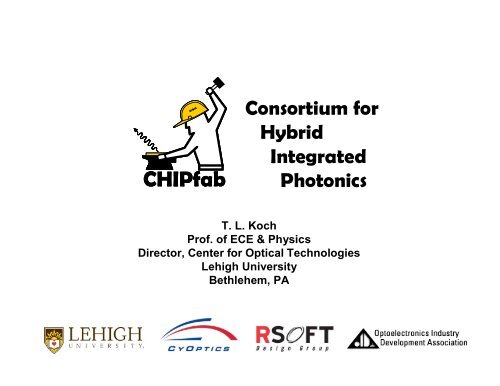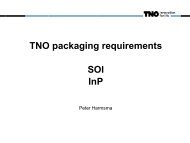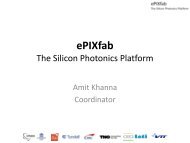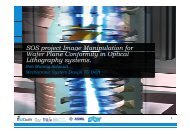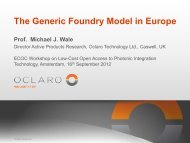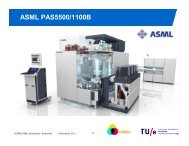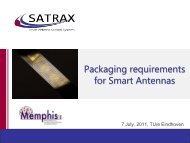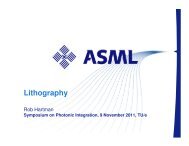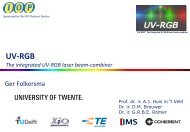Hybrid Integration - JePPIX
Hybrid Integration - JePPIX
Hybrid Integration - JePPIX
You also want an ePaper? Increase the reach of your titles
YUMPU automatically turns print PDFs into web optimized ePapers that Google loves.
CHIPfab<br />
Consortium for<br />
<strong>Hybrid</strong><br />
Integrated<br />
Photonics<br />
T. L. Koch<br />
Prof. of ECE & Physics<br />
Director, Center for Optical Technologies<br />
Lehigh University<br />
Bethlehem, PA
Outline<br />
• Photonic <strong>Integration</strong>: What is working & what is not working.<br />
• What can a foundry approach bring to the table<br />
• Monolithic vs. <strong>Hybrid</strong><br />
• Approach of CHIPfab consortium<br />
• Examples of design cells<br />
• CAD tool goals<br />
• Expected deliverables
Historical State of Industry:<br />
• Each new photonic application has been addressed through in-house<br />
R&D to tweak design and process for highly optimized performance<br />
• Results in lack of maturity in the underlying materials and process<br />
platforms (compared to silicon electronics)<br />
• Insufficient design commonality across customers, markets, and<br />
applications has precluded the development of standardized integration<br />
infrastructure<br />
• Experience of R&D and manufacturing team is that each new product<br />
will require extensive process development and stabilization<br />
– Expensive and time consuming for both manufacturer and customer<br />
• Huge $$$ Non-recurring engineering (NRE)<br />
• Can only afford this engagement for customers with big proven markets and/or deep<br />
pockets<br />
• Can’t even talk seriously to new speculative customers, start-ups, entrepreneurs,<br />
inhibits proliferation of new products and markets<br />
• Leads to a “boutique industry” with little industry-wide shared<br />
infrastructure and common design philosophy
Historical State of Industry:<br />
• Each new photonic application has been addressed through in-house<br />
R&D to tweak design and process for highly optimized performance<br />
No. of Units<br />
Performance<br />
New design breakthrough<br />
(MQW’s, etc.)<br />
Why did this happen<br />
• Huge leverage in core of<br />
network for incremental<br />
improvements in<br />
performance<br />
• High willingness to pay due<br />
to tremendous cost sharing<br />
• Not suitable for supporting<br />
client applications,<br />
incubating new markets, &<br />
driving maturity of<br />
technology
Photonic <strong>Integration</strong> Status in USA<br />
• Strong historical foundation in photonic integration technology, strong role by<br />
Bell Labs, much still retained at CyOptics, Inc.<br />
• Subsequently, US private investment infrastructure has driven world-leading<br />
advances in photonic integration technology:<br />
– III-V (Infinera, but also Agility, Santur, etc., …)<br />
– Si Photonics (Luxtera, Kotura, Lightwire, etc.)<br />
• Issue: These start-ups have been necessarily extremely focused on relatively<br />
narrow, near-term product opportunity to get revenue, return on investment, or<br />
on captive, vertically integrated solution & market differentiation at system<br />
level<br />
• Still no incentive or infrastructure to share or re-use knowledge<br />
– Technology not accessible to broad community for exploratory research and<br />
development of new market opportunities<br />
– Still many of the same challenges in long & expensive product development cycles<br />
• Need to explore feasibility of different business model
What is a Foundry<br />
Foundry:<br />
– A manufacturing capability with the flexibility to produce<br />
different configurations of design elements to create<br />
different products serving different customers and different<br />
markets<br />
- and -<br />
– Underlying processes are stabilized independently of any<br />
particular configuration that may be currently in production<br />
How is this done
CHIPfab<br />
Consortium for<br />
<strong>Hybrid</strong><br />
Integrated<br />
Photonics
• Approach of consortium:<br />
– Not a collection of technical capabilities & tools available for use<br />
– Not a demonstration of the functional creativity achievable with PICs<br />
– A collection of standard design cells that are stabilized by reasonably<br />
high volume commercial products<br />
• Provide end-user CAD tool interface based on combination of<br />
physics-based & parametric modeling of standard design cells and<br />
performance of their combined circuit functionality<br />
• Capability will therefore be somewhat limited at first<br />
– “Foundry design cells” (cells that can be realistically extracted and reused<br />
AS-IS from commercial products<br />
– plus –<br />
What are the Goals<br />
– “Research design cells” (best effort basis, initially no sustainable forces<br />
to maintain stability)
What are the Goals<br />
• Monolithic InP<br />
• Si Photonics<br />
• SiO 2 on Si PLC’s<br />
– No room for religion in this endeavor. Many solutions are<br />
inherently hybrid.
CyOptics Technology<br />
Vertical <strong>Integration</strong> for Photonic Integrated Circuits<br />
Assembly<br />
Robotics<br />
Package<br />
A&T<br />
InP - PLC <strong>Integration</strong><br />
precision placement<br />
high levels of automation<br />
Laser Array<br />
InP Devices<br />
DFB, EA, MZ, PIN/APD,<br />
SOA, SSC, MUX<br />
InP Process Elements<br />
MQW active, SAG, butt joint regrowth,<br />
ridge waveguides<br />
broadband AR coatings<br />
PLC Devices<br />
Couplers, AWGs, SSC,<br />
delay lines, EDWA,<br />
switches, VOAs<br />
PLC Process Elements<br />
high ∆n, low loss waveguides<br />
integrated turning mirror, Er doped<br />
w’guides, low loss mode transitions<br />
AWG MUX<br />
10<br />
All Key Technologies under One Roof
CyOptics has extensive monolithic & hybrid<br />
PIC product capability<br />
Example: 4x25GbE (4x10GbE) TOSA Options<br />
TOSA: Monolithic <strong>Integration</strong><br />
Monitor PD DFB 25G EAM<br />
4x25Gb/s EML<br />
500um x 1500um<br />
TOSA: <strong>Hybrid</strong> <strong>Integration</strong><br />
• Monolithic <strong>Integration</strong> in InP<br />
of arrays of four (4)<br />
− 25G DFB laser<br />
− EA modulators<br />
− Back-facet monitor diodes<br />
with compact MMI coupler<br />
Kotura Inc.<br />
7800um x 3500um<br />
25Gb/s DML<br />
• <strong>Hybrid</strong> <strong>Integration</strong> of a 4<br />
channel DFB (or EML) laser<br />
array with SOI PLC Mux<br />
2660 x 375 um<br />
11<br />
2000um x 375um
Examples of Monolithic & <strong>Hybrid</strong> Design Cells<br />
Passives<br />
Actives<br />
Design Element Monolithic<br />
Commercial<br />
Design Cell<br />
<strong>Hybrid</strong><br />
Commercial<br />
Design Cell<br />
Monolithic<br />
Research<br />
Design Cell<br />
Low-Loss Waveguide <br />
N-way Equal Splitter <br />
Asymmetrical Split/Tap <br />
AWG <br />
Beam Expander <br />
Turning Mirror <br />
Fixed Grating <br />
Polarization Splitter <br />
Polarization Rotator <br />
DFB laser <br />
EA Modulator <br />
MZ Modulator <br />
VOA – EA based <br />
SOA – Variable gain trim <br />
SOA - Booster <br />
SOA - Preamp <br />
High Performance PIN <br />
High Performance APD <br />
Mon or Low Perf PIN <br />
Tunable Phase Section <br />
Tunable Grating
Transmitter Building Blocks<br />
Array of<br />
1.3um DMLs<br />
Array of Spot<br />
Size Converters<br />
Optical Mux<br />
Monolithically<br />
Integrated in InP<br />
<strong>Hybrid</strong> integration options<br />
• CyOptics: butt-coupling<br />
• Alternatives: lens coupling,<br />
evanesence coupling
Key Commercial Design Cell:<br />
Laser Array & PLC <strong>Hybrid</strong> <strong>Integration</strong><br />
Laser Array <strong>Integration</strong> via Passive Alignment<br />
• Laser arrays flip chip<br />
mounted onto PLC:<br />
– Automated visioning<br />
used to locate and align<br />
fiducials on laser array<br />
and PLC<br />
– Array stays aligned<br />
through soldering<br />
process<br />
• Passive alignment<br />
keeps excess CE loss<br />
< 2dB<br />
Highest Levels of Placement Accuracy for Highest Performance & Yield
Receiver Building Blocks<br />
Optical deMux<br />
Array of turning<br />
mirrors<br />
Array of PIN<br />
detectors<br />
Array of TIAs<br />
<strong>Hybrid</strong> integration options<br />
• CyOptics: turning mirror<br />
• Alternatives: lens coupling,<br />
evanesence coupling
Key Commercial Design Cell:<br />
High-Performance Detector & PLC <strong>Hybrid</strong> <strong>Integration</strong><br />
Photo-detector <strong>Integration</strong> via Turning Mirror<br />
TIA<br />
PIN<br />
Solder<br />
(deposited on<br />
PIN)<br />
Integrated PIN detector<br />
Submount<br />
PLC<br />
Waveguide<br />
PIN/APD<br />
TIA<br />
• Detector integration via turning mirror<br />
– High speed and CW tap<br />
• Detector mounted directly on PLC<br />
– ± 10µm alignment required<br />
– die tested prior to attach<br />
• TIA mounted on ceramic HIC<br />
– HICs tested prior to attach<br />
• IL < 0.2dB for 10G PIN<br />
16<br />
Highest Levels of Placement Accuracy for Highest Performance & Yield
Silica PLC Examples<br />
<strong>Hybrid</strong> Mixer for 100G PM-QPSK Rx<br />
17
100 Gb/s PM-QPSK receiver<br />
• Design integrates the best features<br />
of two optical technologies<br />
– Bulk optic polarization splitters<br />
– Silica Planar Lightguide Circuit (PLC)<br />
90°<strong>Hybrid</strong>s<br />
– Integrated balanced detectors on PLC<br />
– OIF compliant form factor<br />
• Features<br />
– Compliant with OIF 100G Coherent Rx<br />
Implementation Agreement<br />
• Full functionality with integrated PBS<br />
• Minimum package size<br />
– Low cost structure hybrid integration<br />
– Low profile surface mount package<br />
Use this package as generic package for many CHIPfab prototype evaluations<br />
• No custom package development in initial round<br />
• Two-fiber capability, 40x27x7mm ample space, ample high-speed & low-speed lines
RSOFT Company Overview<br />
Multi-Level Design Solutions For Photonic Applications<br />
Network Planning<br />
Optical System Simulation<br />
MetroWAND<br />
Artifex<br />
OptSim ModeSYS<br />
Passive and Active Device Design<br />
BeamPROP FullWAVE BandSOLVE<br />
GratingMOD DiffractMOD ModePROP<br />
FemSIM LaserMOD MOST<br />
rsoftdesign.com
Near-Term CAD Goals for Foundry Project<br />
Phyics-based modeling of some design cells<br />
Parametric-based modeling of some active cells<br />
– Allows for future plug-ins of alternate manufacturing partner design<br />
cells<br />
Circuit-level & system-level performance simulation<br />
Layout & design rule checking<br />
– Mapping from functional layout to mask & fab processing will be<br />
internal to manufacturing partner<br />
rsoftdesign.com
AWG WDM Multiplexer (BPM)<br />
AWG Layout:<br />
Simulated Spectral Response:<br />
rsoftdesign.com
SOI Optical Modulator<br />
Modulator Layout<br />
Carrier dependent index change<br />
Phase Shift vs Bias Voltage<br />
Frequency Response<br />
Refs: A. Liu et al., Nature 427, pp. 615-618 (2004).<br />
Soref and Bennett, IEEE JQE, 23, pp. 123-129 (1987).<br />
RSoft Design Group, Photonics West, San Jose, CA, Jan. 2005<br />
rsoftdesign.com
InGaAsP MQW FP Laser<br />
Waveguide cross-section<br />
Lattice temperature profile<br />
L-I-V curves: experiment vs simulation<br />
L-I-V curves: self-heating effects<br />
Refs: Piprek et al, IEEE J. Quantum Electron. 36, 366 (2000).<br />
B.Grote (RSoft Design Group) et al, Proc. SPIE Vol. 4986, pp. 413-422,<br />
Physics and Simulation of Optoelectronic Devices XI (2003).<br />
rsoftdesign.com
Circuit-Level Tool for Optoelectronic Subsystems<br />
Modulator<br />
Laser<br />
rsoftdesign.com
Test & Measurement Equipment Interface<br />
Simulating Optical Links with Dispersion Penalty from Time-resolved chirp (TRC) Measurements<br />
Signal<br />
Pattern Gen<br />
GPIB<br />
40GHz Scope<br />
Pattern<br />
Trigger<br />
DUT<br />
EDFA<br />
Laser/optical modulator<br />
TRC measurement<br />
Interface to system simulation<br />
PC/GPIB card<br />
Simulation s/w<br />
rsoftdesign.com
Integrated Framework: CAD Layout<br />
3D PBG Structure<br />
CMOS Device with Integrated Lenses<br />
rsoftdesign.com
What are the Goals<br />
• Near-term project strategy:<br />
– Demo of particular functional product prototype for customer<br />
using combination of commercialized cells<br />
• New transceiver target, for example<br />
– Show that same design cells, perhaps with addition of a few<br />
other cells, can deliver quite different functionality with other<br />
mainstream “product’ configurations<br />
• Coherent functionality, OPLL, sensors, etc.<br />
– Show that capabilities can be extended (functionality, speed,<br />
spectral efficiency, etc., or driven to smaller footprint or power<br />
(monolithic), etc., using “research cells”<br />
– Provide “generic evaluation package” capability to take<br />
foundry prototyping cost out (i.e., not targeting any optimized<br />
product-specific foundry packaging at this point)
GOALS of Project<br />
CHIPfab<br />
Photonic <strong>Integration</strong> Foundry Attributes:<br />
• Once realized, the principal features of the Photonics <strong>Integration</strong> Foundry<br />
model should provide:<br />
– Base technology in place providing high-performance design cells for hybrid<br />
and monolithic integration supported by stabilized manufacturing processes;<br />
– End user application developer CAD tools for design cell layout and<br />
performance modeling;<br />
• Virtual foundry design coordination team providing interface between applications<br />
developers and industry manufacturing partners; users do not talk to manufacturers<br />
• Some potential for shared wafer processing costs across multiple customers for costeffective<br />
prototyping;<br />
– Immediate pathway from prototyping to manufacture for dramatic reduction in<br />
R&D cycles.


